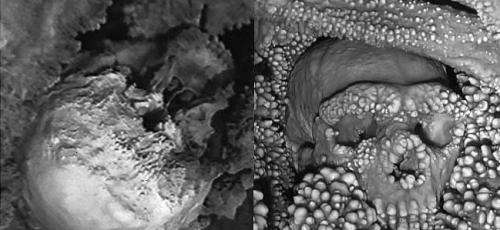April 3, 2015 report
Altamura Man yields oldest Neanderthal DNA sample

(Phys.org)—A team of researchers working in Italy has confirmed that Altamura Man was a Neanderthal and dating of pieces of calcite which were on the remains has revealed that the bones are 128,000 to 187,000 years old. In their paper published in the Journal of Human Evolution, the team describes how they extracted a small bone sample and examined it and what they found by doing so.
Altamura Man was discovered in a cave in southern Italy in 1993 by cave explorers. The finding was reported to researchers at the University of Bari. The remains were embedded in rock and were covered in a thick layer of calcite (they lie in a karst borehole rich in limestone amid running water.) It was thought that excavating the remains would cause irreparable damage and thus, they have remained in situ for over twenty years, leaving researchers to rely on casual observation for their studies. For that reason, there was some debate initially about morphology and age. Subsequent study led to a consensus that the remains (only the head and part of a shoulder are visible) were that of an archaic Neanderthal, of a Homo genus believed to have been widespread in Europe 200,000 to 40,000 years ago.
The researchers with the current project began their work six years ago—a tiny part of shoulder bone (and stalactite fragments) was extracted and brought back to the lab for study. Analysis by Uranium-thorium dating revealed that the calcite was formed 172,000 to 130,000 years ago—during the penultimate quaternary glaciations period. The team also reports that samples of DNA have also been retrieved from the sample, and because of the age, represent the oldest such samples ever recovered from Neanderthal remains.
It is believed that Altamura Man wound up in such a peculiar spot after falling in a well and getting stuck—it is assumed he starved to death, or died from lack of water intake. The researchers next plan to test the DNA sample to see if it can be sequenced—if so, they are hopeful it might reveal new details about the evolution of hominids in general and perhaps more about the early history of the Neanderthal.
More information: The Neanderthal in the karst: First dating, morphometric, and paleogenetic data on the fossil skeleton from Altamura (Italy), Journal of Human Evolution, Available online 21 March 2015 DOI: 10.1016/j.jhevol.2015.02.007
Abstract
In 1993, a fossil hominin skeleton was discovered in the karst caves of Lamalunga, near Altamura, in southern Italy. Despite the fact that this specimen represents one of the most extraordinary hominin specimens ever found in Europe, for the last two decades our knowledge of it has been based purely on the documented on-site observations. Recently, the retrieval from the cave of a fragment of bone (part of the right scapula) allowed the first dating of the individual, the quantitative analysis of a diagnostic morphological feature, and a preliminary paleogenetic characterization of this hominin skeleton from Altamura. Overall, the results concur in indicating that it belongs to the hypodigm of Homo neanderthalensis, with some phenetic peculiarities that appear consistent with a chronology ranging from 172 ± 15 ka to 130.1 ± 1.9 ka. Thus, the skeleton from Altamura represents the most ancient Neanderthal from which endogenous DNA has ever been extracted.
Journal information: Journal of Human Evolution
© 2015 Phys.org




















